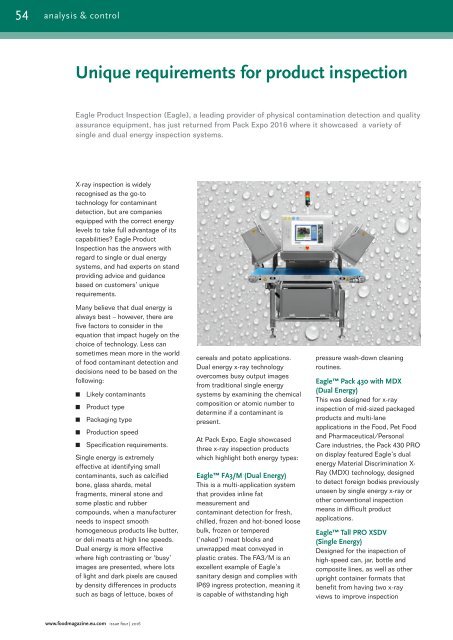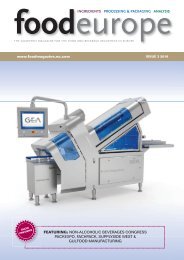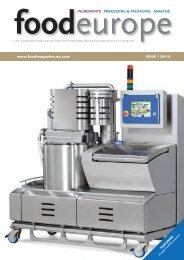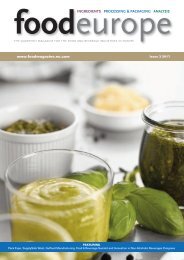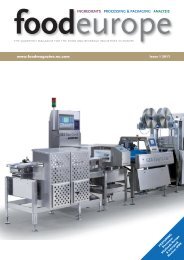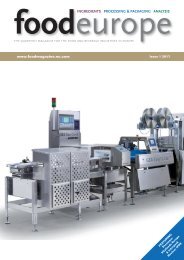FoodEurope Issue 4 2016
You also want an ePaper? Increase the reach of your titles
YUMPU automatically turns print PDFs into web optimized ePapers that Google loves.
54<br />
analysis & control<br />
Unique requirements for product inspection<br />
Eagle Product Inspection (Eagle), a leading provider of physical contamination detection and quality<br />
assurance equipment, has just returned from Pack Expo <strong>2016</strong> where it showcased a variety of<br />
single and dual energy inspection systems.<br />
X-ray inspection is widely<br />
recognised as the go-to<br />
technology for contaminant<br />
detection, but are companies<br />
equipped with the correct energy<br />
levels to take full advantage of its<br />
capabilities? Eagle Product<br />
Inspection has the answers with<br />
regard to single or dual energy<br />
systems, and had experts on stand<br />
providing advice and guidance<br />
based on customers’ unique<br />
requirements.<br />
Many believe that dual energy is<br />
always best – however, there are<br />
five factors to consider in the<br />
equation that impact hugely on the<br />
choice of technology. Less can<br />
sometimes mean more in the world<br />
of food contaminant detection and<br />
decisions need to be based on the<br />
following:<br />
n Likely contaminants<br />
n Product type<br />
n Packaging type<br />
n Production speed<br />
n Specification requirements.<br />
Single energy is extremely<br />
effective at identifying small<br />
contaminants, such as calcified<br />
bone, glass shards, metal<br />
fragments, mineral stone and<br />
some plastic and rubber<br />
compounds, when a manufacturer<br />
needs to inspect smooth<br />
homogeneous products like butter,<br />
or deli meats at high line speeds.<br />
Dual energy is more effective<br />
where high contrasting or ‘busy’<br />
images are presented, where lots<br />
of light and dark pixels are caused<br />
by density differences in products<br />
such as bags of lettuce, boxes of<br />
cereals and potato applications.<br />
Dual energy x-ray technology<br />
overcomes busy output images<br />
from traditional single energy<br />
systems by examining the chemical<br />
composition or atomic number to<br />
determine if a contaminant is<br />
present.<br />
At Pack Expo, Eagle showcased<br />
three x-ray inspection products<br />
which highlight both energy types:<br />
Eagle FA3/M (Dual Energy)<br />
This is a multi-application system<br />
that provides inline fat<br />
measurement and<br />
contaminant detection for fresh,<br />
chilled, frozen and hot-boned loose<br />
bulk, frozen or tempered<br />
(‘naked’) meat blocks and<br />
unwrapped meat conveyed in<br />
plastic crates. The FA3/M is an<br />
excellent example of Eagle’s<br />
sanitary design and complies with<br />
IP69 ingress protection, meaning it<br />
is capable of withstanding high<br />
pressure wash-down cleaning<br />
routines.<br />
Eagle Pack 430 with MDX<br />
(Dual Energy)<br />
This was designed for x-ray<br />
inspection of mid-sized packaged<br />
products and multi-lane<br />
applications in the Food, Pet Food<br />
and Pharmaceutical/Personal<br />
Care industries, the Pack 430 PRO<br />
on display featured Eagle’s dual<br />
energy Material Discrimination X-<br />
Ray (MDX) technology, designed<br />
to detect foreign bodies previously<br />
unseen by single energy x-ray or<br />
other conventional inspection<br />
means in difficult product<br />
applications.<br />
Eagle Tall PRO XSDV<br />
(Single Energy)<br />
Designed for the inspection of<br />
high-speed can, jar, bottle and<br />
composite lines, as well as other<br />
upright container formats that<br />
benefit from having two x-ray<br />
views to improve inspection<br />
www.foodmagazine.eu.com issue four | <strong>2016</strong>


